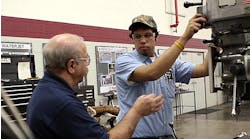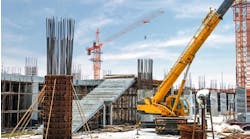A high-efficiency pleated bag-style (cartridge) dust collector is used to handle foundry sand containing lead and other metals.
Finding the best solution to foundry dust collection challenges related to melt pots/pouring, sand shakeout, sand reclamation, and grinding, can be a complex process. To complicate the issue, some of the technologies traditionally used to clean up dust and fumes – wet scrubbers, industrial baghouses, or pleated down flow-style baghouses – can be extremely costly and/or prone to performance problems.
Choosing the best dust collection system for a foundry involves several areas of investigation. By reviewing the following topics with a knowledgeable equipment supplier and knowing the right questions to ask, foundry operators will be better equipped to make informed decisions on dust collection and to focus on productivity, not problems.
Will the dust collector comply with emission requirements?
Foundry professionals today must deal with an increasingly complex alphabet soup of regulations as the EPA, OSHA, and other organizations continue to tighten air quality and safety requirements. Meeting these requirements should be foremost in any dust collection plan.
OSHA has established permissible exposure limits (PEL) for hundreds of dusts ranging from nonspecific or “nuisance” dust to highly toxic substances. These limits are based on 8-hour, time-weighted average (TWA) exposure. (For more information, on PELs visit osha.gov/SLTC/pel.) Many foundry dusts are hazardous and require dust collectors equipped with very highefficiency filtration media to meet emission requirements.
Pleated bag-style collectors (also known as cartridge collectors), which combine high-efficiency filtration with compact size and reduced pressure drop, will be the system of choice in most cases. Where toxic materials such as lead and silica are involved, HEPA after-filters – sometimes called safety monitoring filters – are added to create a virtually zero-emissions system. This can be an effective way to contain dusts and fumes generated from furnaces, conveyor transfer points, enclosures from vibrating conveyors, shot-blasting equipment, grinding of castings, and other processes.
How do you know if your dust collector will comply with emission thresholds? The equipment supplier should provide a written guarantee stating the maximum emissions rate for the equipment over an 8-hour TWA.
Do I have a combustible dust issue?
Combustible-dust explosions have made headlines many times in recent years. As a result, OSHA and the National Fire Protection Association (NFPA) have been implementing more stringent requirements for applications involving explosive dusts. Examples include processes that generate aluminum dust, or in which oil content becomes mixed with recycled dust.
The only way to know for sure whether your dust is combustible is to undergo explosibility testing in accordance with ASTM test methods. If the dust is determined to be even slightly explosive, the dust collector will need to be equipped with explosion venting or suppression equipment.
Will my collector fix the problem?
What else is the dust collector expected to do? Perhaps it must reclaim valuable product, accommodate changes or expansions in the plant, or solve a performance problem related to an older dust collection system.
A good way to pinpoint objectives is by using a site survey form available from most equipment suppliers. This form typically calls for information on the process and the material to be collected, operating hours and conditions, electrical requirements, airflow and pressure ratings, and other specifics of the application. The survey also will call for detailed information on the physical properties of the dust, which can be determined by laboratory testing (different from the combustibility testing described above).
Will it perform reliably?
Dust collection equipment can be a maintenance headache, but this need not be the case. Reliability problems typically stem from neglecting or misunderstanding details about the unit’s performance during the initial selection process or when changes are made in the foundry. By following the steps above, you can help to ensure more reliable performance from your dust collector.
When selecting equipment, it also helps to be aware of design and technological improvements that can enhance reliability and performance. Examples include:
• Horizontal vs. vertical cartidge mounting: Some pleated bags or cartridges are mounted on their sides. With horizontal mounting the dust does not get cleaned off the top of the filter, causing the dust to blind at least one third of the filter. Also, be cause the incoming dust is dumped on top of the filters, there is no pre-separation of heavy or abrasive particles from the air stream. This situation can greatly shorten filter life or pose a fire hazard.
An antidote to this problem is a system using vertically mounted filters. The best designs incorporate a high, side-entry inlet with a series of staggered baffles that distribute the air and separate out larger particles, dropping them straight into the hopper. This reduces the load on the filters and helps to eliminate problems encountered with horizontal mounting.
• Advances in pleat spacing: Most pleated bags use tightly packed media configurations. Though they offer high efficiency, much of the media surface area is unavailable for filtering, allowing dust to remain trapped within the filter even after pulse cleaning. More recent “open pleat” designs allow the entire depth of the pleat to be utilized. The filter holds more dust between cleaning pulses. The open, breathable design also results in significantly lower pressure drop as well as improved dust release characteristics during pulse cleaning, using fewer pulses, and therefore less energy.
Will it provide the best possible return on investment?
Where feasible, the best way to maximize return on investment (ROI) is to use a recirculating dust collection system equipped with a HEPA safety monitoring filter. By recycling heated or cooled air back through the foundry, the cost to replace that conditioned air is eliminated, bringing significant energy savings. By containing the air indoors, you can deal with OSHA and avoid time-consuming EPA permitting. Where hazardous gases are generated, however, a recirculating system cannot be used.
Finally, it is not initial cost but total cost of ownership (TCO) that counts. What will it cost to operate and maintain the unit and replace the filters? How much compressed air will the collector use? Does the system incorporate “green” features such as variable frequency drives and premium efficiency fan motors that will reduce energy costs, and may be eligible for utility rebates or incentives? Can it save on other resources, such as the water required with wet scrubbers? A reputable equipment supplier can project these costs mathematically and help to analyze the best ways to improve ROI and get the most out of dust collector performance – again allowing you to focus on productivity, not problems.









